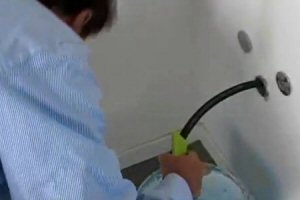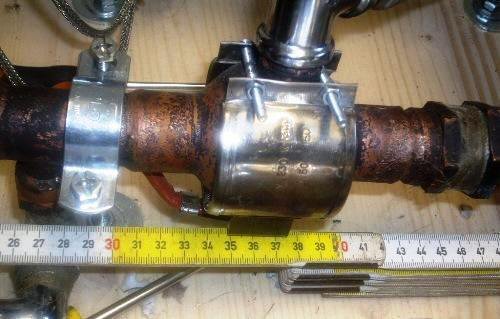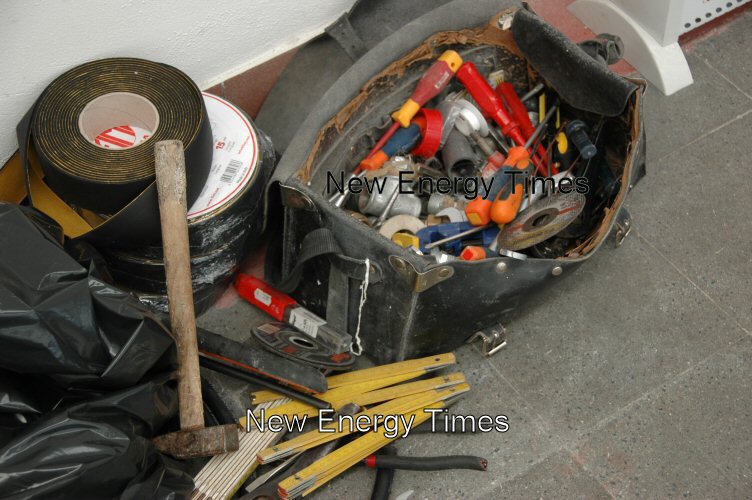Correcting the LENR Record (Chemical & Engineering News)

Rossi feeding the water from his E-Cat through a black hose and into a drain hole in the next room. Click for video.
Nov. 15, 2016 – By Steven B. Krivit –
A Nov. 7, 2016, deeply flawed cover story by Stephen Ritter in Chemical & Engineering News, a publication of American Chemical Society, requires me to correct the record. Although Ritter has written on the topic of LENR (low-energy nuclear reactions) before, the subject is extremely challenging for nonspecialist journalists. Landmines are easy to encounter. Confusion is common.
Unfortunately, as his article reveals, Ritter relied primarily on a single source for key facts about LENRs and did not check those facts independently. Ritter was duped by a professor who has had a long career in science and worked for a reputable university but is one of several scientists who in recent years has promoted fraudulent claims about LENR research. Ritter declined to speak with me on the record about his article.
Summary: Ritter’s story contains three major factual errors:
1. Ritter wrote that electrochemical LENR systems can produce more than 25 times as much power as they draw. In fact, typical results of those systems only produce excess heat at an average peak of 1.38 times the electrical input power.
2. Ritter wrote that nickel-hydrogen LENR systems can produce more than 400 times as much power as they use. In fact, the best credible results of those systems have produced excess heat similarly, at an average peak of 1.3 times the electrical input power.
3. Ritter wrote that Andrea Rossi has developed working versions of industrial 1-MW thermal power plants. In fact, Rossi has been convicted of fraud in a previous business venture, and all evidence indicates that he has nothing but smoke and mirrors now and has probably perpetrated a fraud in his current power-plant claims.
It’s Not Fusion
The idea of room-temperature “cold fusion,” as put forward by electrochemists Martin Fleischmann and Stanley Pons, has no experimental or theoretical support. It never did. It was a mistake to label this research “fusion” 27 years ago, and it is a mistake to continue doing so. Experimental data observed by LENR scientists directly disproves the idea that they are caused by room-temperature fusion. [1]
However, there is abundant experimental and theoretical evidence that what they mistakenly thought was fusion is based on a previously unrecognized set of nuclear reactions, primarily weak interactions. The distinction is crucial. Low-energy nuclear reactions most likely are explained by the creation of ultra-low-momentum neutrons followed by subsequent neutron-capture processes, not deuterium-deuterium nuclear fusion between charged particles. [2]
When I am asked for simple definitions to distinguish between the two terms, I provide the following: LENRs are non-fusion-based nuclear reactions that can occur at or near room temperature. “Cold fusion” is an erroneous hypothesis of nuclear fusion reactions that occur at or near room temperature. Even Robert Park, the former spokesman of the American Physical Society, and outspoken critic of the field, recognized this distinction in 2009 in his newsletter. This year, the Library of Congress recognized the distinction when it created a new subject-matter heading for LENR.
Of course, there are scientists who still believe that LENRs are or might be the result of room-temperature fusion. After years of discussions with these people, I am convinced that they will never relinquish their beliefs and they will go (or have gone) to extreme lengths to seek validation for their belief. But science is not about belief.
Alternatively, a subset of researchers in the field has always known that neutron-based transmutation reactions were far more likely to explain the experimental results than the idea of room-temperature fusion. In 1995, these researchers held the first Low-Energy Nuclear Reactions Conference to distinguish their experimental findings and interpretations from their fusion-believing peers. [3]
The 25x Claim
Ritter wrote that “electrochemical systems can output more than 25 times as much energy as they draw.” This is wrong. Here’s the history on the “25 times” claim. In November 2004, Arik El-Boher, a researcher with the now-defunct Energetics Technologies company in Omer, Israel, reported one impressive electrochemical experiment, #64a, that produced a calorimetrically measured excess-heat gain equivalent to 25 times the electrical input power to the cell. The Energetics group was never able to repeat the result of that extraordinary experiment. In that same series of experiments, the next best experiment, #64b, showed a peak heat gain of 15 times, and another experiment, #56, showed a peak gain of eight times. [4]
In 2008, when I was editing the American Chemical Society Low-Energy Nuclear Reactions Sourcebook, I received a paper from a consortium of scientists including those from Energetics Technologies, SRI International and ENEA, the Italian National Agency for New Technologies, Energy and the Environment in Frascati, Italy. [5] They reported their best efforts to replicate the Energetics Technologies #64a experiment. Researcher Vittorio Violante at ENEA — claimed by his SRI International colleague Michael McKubre to be the only scientist in the world who knew how to reliably produce good working cathodes — could not reproduce the Energetics Technologies #64a excess-heat result.
Replication attempts were performed at SRI from 2006 to 2007. A set of 23 experiments measured excess heat that equated to an average peak of 1.38 times the electrical input power. The typical amount of calorimetrically measured excess heat, as has been the case nearly throughout the history of the field, was only in the milliwatt range. Four of the 23 experiments showed a peak excess heat greater than 1 Watt: 1.800, 2.066, 1.250 and 2.095 Watts. By the time McKubre resigned from SRI International in 2016, he was still unable to produce further-improved excess-heat results. Nevertheless, these data support the assertion that anomalous heat production occurs in LENRs.
The 400x Claim
Ritter also wrote that “the other main branch of the field uses a nickel-hydrogen setup, which can produce greater than 400 times as much energy as it uses.” This too, is wrong. The best result in nickel-hydrogen-gas LENR experiments was reported in 1998 by Francesco Piantelli and his colleagues, and published in the peer-reviewed journal of the Italian Physical Society, Il Nuovo Cimento. [6] In that experiment, researchers measured a peak excess heat of 38.9 Watts, with an electrical input power of 101.5 Watts. That experiment produced excess heat continuously for 278 days. At its peak, the experiment produced 1.3 times as much heating power as the electrical input power that it used, not 400 times.
The Rossi 1-MW Claim
After presenting these grossly exaggerated LENR excess-heat values as real, Ritter juxtaposed that information with the sordid story of Andrea Rossi, an Italian businessman now living in Florida, and his E-Cat (Energy Catalyzer) claims. Since 2011, Rossi has claimed to have a commercially viable LENR system that produces one megawatt of thermal power from tiny amounts of hydrogen gas and nickel. Rossi’s claim, compared with the credible excess-heat measurements in the field, is the equivalent of someone claiming to have developed an automobile capable of 40 million miles per gallon. Unfortunately, Ritter gave no such indication of the dubiousness of Rossi’s claim to readers.
Crucially, following Nagel’s guidance, Ritter failed to tell Chemical & Engineering News readers that Rossi has no peer-reviewed, published scientific paper to support any aspect of his work. Ritter failed to mention that Rossi has not publicly shown any credible evidence of a working commercial system, nor publicly provided any credible evidence of a single system sale. The long trail of technical nonsense, broken promises, and lies are listed in this timeline.
Ritter failed to mention that Rossi had been convicted of fraud, that he had served time in prison twice, and that he is being sued now for fraud. Ritter did mention that Rossi was awarded a contract from the U.S. Army based on Rossi’s claim that he could produce thermoelectric devices that would yield unprecedented heat-to-electricity conversion efficiency. Ritter wrote that Rossi delivered devices that “did not work according to specifications.” Actually, Rossi told the Army he would make devices that could produce 800-1,000 Watts each but that, in the end, Rossi’s devices produced only 1 Watt of direct-current electricity.

Giuseppe Levi, professor of physics at the University of Bologna and a close associate of Andrea Rossi
Ritter wrote that Rossi’s tests of his E -Cat were independently validated by an Italian and Swedish science team. In fact, those tests, performed in 2012 and 2013, were thoroughly discredited by 2014. Not only was Rossi present during the tests, he took part in the experimental activities. Rossi enticed Giuseppe Levi, a professor of physics at the University of Bologna, to be the lead author of this paper. Rossi had duped Levi in 2010 into believing that Rossi had correctly measured the input power to his E-Cat. Levi took Rossi on faith. Nagel took Rossi and Levi on faith, then Ritter took Nagel on faith.
Ritter also wrote that Rossi had held demonstrations for the public and potential investors. Ritter apparently wasn’t aware, and failed to explain, that, between January and October 2011, Rossi performed 11 tests, and in each of those 11 tests, observers identified blatant deficiencies in his heat-measurement techniques that could have easily been used to manipulate his claimed amount of excess heat production.
Rossi’s tests and demonstrations have nothing to do with science and everything to do with sleight of hand designed to attract gullible investors. In fact, Rossi is now $11 million richer, according to court documents, thanks to finding Thomas Darden and his 13 investment partners for Industrial Heat.
Ritter’s primary source for technical information about LENRs was David J. Nagel, a research professor at George Washington University. Nagel, who also owns a consulting company called NUCAT, told Ritter that he doesn’t believe that Rossi is a fraud. In May 2011, Nagel gave a presentation at the 15th International Conference on Emerging Nuclear Energy Systems, in San Francisco, California. He said that Rossi’s apparatus had heated a factory in 2007 for 24 hours per day for six months and, as a result, had reduced the factory’s electricity bill by 90 percent.
Meanwhile, in his nearly empty garage in Bologna, Italy, which he called a laboratory, Rossi and his collaborators always seemed to be wearing heavy coats while working on the E-Cat system. Nagel also said that Rossi had 97 systems operating in four countries. Yet like Bigfoot or the Loch Ness Monster, credible evidence of Rossi’s extraordinary excess-heat claims has been elusive.

Sergio Focardi (left) and Andrea Rossi (right) in front of their Model 1 E-Cat in their Bologna laboratory. Click here for other E-Cat satire and images.

Beneath the aluminum foil and insulation, the heart of the E-Cat system is a copper pipe surrounded by an electrical resistance heater.
In 2015, despite a complete absence of credible scientific data or commercial evidence for Rossi’s E-Cat claims during a five-year period, Nagel published a paper in Current Science, promoting Rossi’s E-Cat as real and as scientifically credible. [7] Moreover, in that paper, Nagel published a table of results from gas-loading experiments. Nowhere in that table did Nagel identify the source of that data. On the previous page, his text reveals the data came from Rossi. [8] By all indicators, that data was fabricated. Nagel copied it from a paper written by Rossi and Sergio Focardi, then a retired and elderly scientist whom Rossi had befriended late in his life. Rossi published that data only on his blog. [8] This is the source of Ritter’s claimed nickel-hydrogen power gain of 400 times.

Tools used by Carlo Leonardi, Rossi’s plumber, to build and maintain his E-Cat systems (Photo: S.B. Krivit)
All of the information about Rossi — and Nagel — is in my book Hacking the Atom, which Ritter received on Sept. 10. However, my impression is that he didn’t read it. Nagel also told Ritter that LENR is “not understood theoretically.” As my book shows, in 2005, it was Nagel who first pitched Allan Widom and Lewis Larsen’s theory to me.
“I believe that this paper describes what may prove to be a viable mechanism for cold fusion,” Nagel wrote.
However, the problem that soon emerged for Nagel was that the Widom-Larsen paper proved there was a viable mechanism for neutron-based LENRs, not room-temperature deuterium-deuterium fusion. Loyalty to his longtime friends in the field took precedence for Nagel, and he soon began to ignore the theory for reasons as unprofessional as the fact that neither Widom nor Larsen spoke at the 14th International Conference on Cold Fusion that Nagel and his fusion-believing friend Michael Melich had organized.
The Widom-Larsen theory is unique in the history of the field in that it easily explains most of the well-measured experimental data in the field, is mathematically correct, does not rely on new physics, can be understood by scientists and non-scientists alike, and has received unprecedented third-party support. Several years later, in 2010, the Widom-Larsen group provided a broad summary of additional details of their theory. Their paper published simultaneously in the peer-reviewed Pramana – Journal of Physics published by the Indian Academy of Sciences and in an American Chemical Society reference book. (For full disclosure, I was the co-editor of that ACS book, and I solicited the paper.) [9, 10]
By relying solely on Nagel for his technical information about LENRs, Ritter unwittingly promoted Rossi and his unsubstantiated E-Cat claims while ignoring the work of many legitimate researchers in the field.
Legitimate Research
Ritter did not mention that major industrial companies such as Mitsubishi Heavy Industries, Toyota and Nissan Motor Company are engaged in legitimate LENR research and development. Many of their researchers have published papers in respectable peer-reviewed Japanese physics journals. Ritter failed to mention major news: the Japanese government is now funding LENR research.
Ritter chose not to report any of the 30 peer-reviewed LENR research papers from the now-retired LENR team from the US Navy’s Space and Naval Warfare Systems Center (SPAWAR) in San Diego. I spoke with two of the members of that former group on Nov. 8, Frank Gordon and Pamela Mosier-Boss. They are each independently continuing their LENR research. Ritter made no attempt to contact them. Neither of them is a reliable source for theoretical interpretation of LENR research, but experimentally, most of their published work establishes them as experts. Ritter did not contact chemist Jerry Smith, who co-wrote several of the peer-reviewed papers with the SPAWAR group when he worked for the U.S. Department of Energy.
Thus, the American Chemical Society public affairs office, using Ritter’s article as the sole source of information, wrote a press release titled “What the ‘Cold Fusion’ Debacle Has Revealed.” Not only did Ritter’s article mislead readers of Chemical & Engineering News and members of the public who read the press release, but it also misled his colleagues at the American Chemical Society.
The field of LENRs is littered with landmines: political, scientific, and sociological. My book Hacking the Atom is intended to help journalists, investors, decision-makers, interested scientists, and the public navigate this potentially treacherous field by providing a comprehensive overview suitable for a broad audience.
LENR research encompasses experimentally observed phenomena, including direct and indirect evidence of the products of hard-radiation-free nuclear reactions. Well-measured observations include evidence of isotopic shifts, transmutations from one element to another, thermal effects inexplicable and inconsistent with Joule heating, and melted metals — all with low-energy inputs and at moderate system temperatures.
Such results are surprising, to say the least. In the last 100 years of chemistry and physics, most scientists have thought that nuclear reactions could occur only in high-energy physics experiments and in massive nuclear reactors. The potential of LENRs could be far beyond our wildest imaginations.
References
1. Krivit, Steven, B. (Aug. 20, 2008) “Low-Energy Nuclear Reaction Research — 2008 Update,” Presented at American Chemical Society national meeting, Philadelphia, PA
2. Widom, Allan and Larsen, Lewis (March 9, 2006). “Ultra-Low-Momentum Neutron-Catalyzed Nuclear Reactions on Metallic Hydride Surfaces,” European Physical Journal C – Particles and Fields, 46(1), p. 107-110
3. Krivit, Steven, B. (Sept. 2016) Hacking the Atom: Explorations in Nuclear Research, Vol. 1, Pacific Oaks Press
4. Dardik, Irving, Zilov, Tanya, Branover, Herman, El-Boher, Arik, Greenspan, Ehud, Khachaturov, Boris, Krakov, Vitaly, Lesin, Shaul, and Tsirlin, Mark (presented Nov. 2004) “Excess Heat in Electrolysis Experiments at Energetics Technologies,” Proceedings of the 11th International Conference on Cold Fusion, p. 84-101.
5. McKubre, Michael C. H., Tanzella, Francis L., Dardik, Irving, El Boher, Arik, Zilov, Tanya, Greenspan, Ehud, Sibilia, Concita, and Violante, Vittorio (Aug.2008) “Replication of Condensed Matter Heat Production,” Low-Energy Nuclear Reactions Sourcebook, Marwan, Jan and Krivit, Steven B., editors, American Chemical Society/Oxford University Press
6. Focardi, Sergio, Gabbani, V., Montalbano, V., Piantelli, Francesco, and Veronesi, S., (Nov. 1998) “Large Excess Heat Production in Ni-H Systems,” Il Nuovo Cimento, 111A, p. 1233-1242
7. Nagel, David J. (Feb. 25, 2105) “Energy Gains From Lattice-Enabled Nuclear Reactions,” Current Science, 108(4), p. 641-5
8. Focardi, Sergio and Rossi, Andrea (Feb. 28, 2010) “A New Energy Source From Nuclear Fusion” post on Rossi’s blog, deceptively titled “Journal of Nuclear Physics.”
9. Srivastava, Yogendra. N., Widom, Allan and Larsen, Lewis (Oct. 2010) “A Primer for Electro-Weak Induced Low Energy Nuclear Reactions,” Pramana – Journal of Physics, 75(4) 617-637
10. Srivastava, Yogendra N., Widom, Alan and Larsen, Lewis (Oct. 2010) “A Primer for Electro-Weak Induced Low Energy Nuclear Reactions,” Low-Energy Nuclear Reactions and New Energy Technologies Sourcebook (Vol. 2), Marwan, Jan and Krivit, Steven B., editors, American Chemical Society/Oxford University Press, p. 253-270
Questions? Comments? Submit a Letter to the Editor.
- Response from Bibiana Campos-Seijo, Chemical & Engineering News Editor-in-Chief: “Thank you very much for sending the link to your story in New Energy Times. I was very interested to read it.”
- Response from Michael Bernstein, Senior Science Communications Officer at American Chemical Society: “Thanks for sharing.”
- Response from Stephen Ritter: None
Nov. 18, 2016
Wheels of justice closing in on Rossi: Judge Cecilia M. Altonaga denies motion to dismiss Industrial Heat lawsuit. Describes Rossi’s actions to include “complete fabrications … using fatally flawed methodologies.” Download Motion to Dismiss

